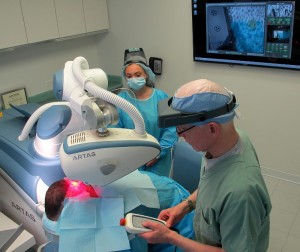Q: I have been reading about Robotic FUE and have seen some photos on your website of you operating the ARTAS robot using what looks like a remote control. What is that thing and how does it control the robot? — C.B., Greenwich, CT
A: The ARTAS robot uses a dual operating system when performing follicular unit extraction. One station consists of a desktop computer adjacent to the robot. This station is used to establish the basic parameters of the transplant such as the spacing of grafts, the angle and depth of the harvest, which size follicular units will be targeted, and a host of other important variables.
The hand-held pendant is used by the operator situated next to the patient. The remote has more limited options – the main ones being depth adjustment and to immediately suspend the action of the robot. Many of the parameters are determined automatically by the robot’s computer to maximize the accuracy of the harvesting. The robot also makes real-time adjustments to these variables during the hair restoration procedure.
The physician sets the parameters at the computer monitor and, once the settings are determined, he/she sets the tensioner grid on the patient’s scalp. The tensioner determines where the grafts will be harvested. The grid is moved approximately every 130 harvests. The robot can be operated at the computer terminal and through a mobile pendant. The physician often alternates with a trained assistant between that station and using the pendant.
Besides the involvement in the operation of the robot, there are many other important physician-dependent steps to the hair transplant including the planning and design of the procedure, and recipient site creation. Other steps, such as the microscopic sorting and trimming of harvested follicular unit grafts and graft placement, are often performed by trained staff, but require the physician’s close supervision.
- When is it Best to Feather in Robotic FUE?
- Is Manual FUE Better Than Robotic FUE Because The Physician Can “Feel” The Follicle During Extraction?
- Can I Have Robotic FUE If I Have Gray Hair or Curly Hair?
- How are Recipient Sites Programmed into the ARTAS Robot?
- Will Robotic FUE Reduce the Cost Per Graft for FUE Procedures?






